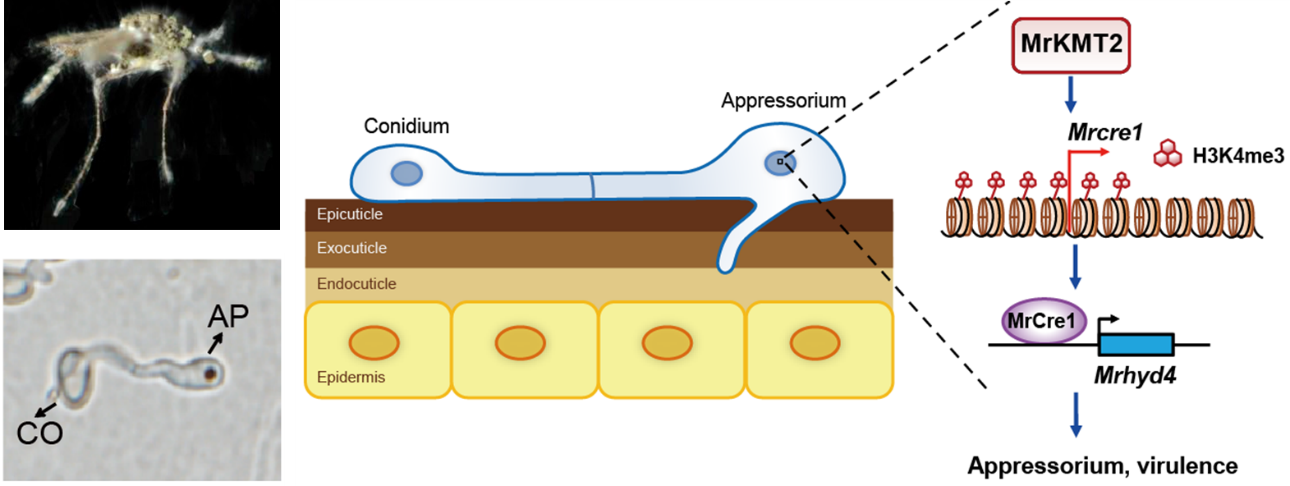The KMT2-Cre1-Hyd4 regulatory pathway modulates infection-related morphogenesis and pathogenicity in an insecticidal fungus
The increasing global threat of emerging and reemerging mosquito-borne diseases poses a serious human health problem. Because of the lack of vaccines or effective treatments against these human pathogens, vector control using chemical insecticides remains the major tool for combating mosquito-borne diseases. However, the growing threat of mosquito insecticide resistance requires the development of more sustainable vector control tools that can overcome insecticide resistance. Fungal biopesticides are a promising environmentally friendly alternative to chemical insecticides. The entomopathogenic fungi such as Metarhiziumrobertsii and Beauveria bassiana are equally effective at killing insecticide-resistant and insecticide-susceptible mosquitoes and have been considered the next-generation control agent for mosquito vectors.
Entomopathogenic fungi are the only pathogens that can infect the insect host directly through the exoskeletons. During the course of infection in insects, the fungi undergo marked infection-related morphological differentiation on host cuticles. When the spores land on the insect’s cuticle, the fungus receiveshost-specific cues on the cuticle to stimulate spore germination, and then differentiate specialized penetration organ(infection structure), so called appressorium. Through a combination of mechanical pressure and cuticle-degrading enzymes, the fungus penetrates through the cuticle and enter into hemocoel, overwhelmsinsect defenses and eventually killsthe host. The complex infection-related morphological transitions of the fungus require rapid and fine-tuning regulation of gene expression programs. However, regulatory mechanisms offungal infection-related morphogenesis are poorly understood.
Prof. Sibao Wang from CAS Center for Excellence in Molecular Plant Sciences (CEMPS)and CAS Center for Excellence in Biotic Interactions, and Prof. Gang Wei from CAS-MPG Partner Institute for Computational Biology (PICB),Shanghai Institute of Nutrition and Health, Shanghai Institutes for Biological Sciences, Chinese Academy of Sciences (CAS) and their colleagues revealed that the KMT2-Cre1-Hyd4 regulatorypathway plays a crucial role in coordinated regulation of theinfection-related morphogenesis and fungal pathogenicity againstmosquitoes. They found that a histone lysine methyltransferase KMT2 in M. robertsii (MrKMT2) was up-regulated upon cuticle induction. MrKMT2 is responsible for methylation at H3K4 and regulates appressorium formation and fungal virulence by up-regulating the transcription factor gene Mrcre1 via H3K4 trimethylation (H3K4me3) during mosquito cuticle infection. MrCre1 further activates the expression of cuticle-induced genehydrophobin 4(Mrhyd4) to modulate appressorium differentiation and fungal virulence. Overall, the identified MrKMT2-MrCre1-MrHyd4regulatory pathway allows the fungus to reprogram its gene expressionfor the appressorium differentiation during cuticle infection.These findings reveal that the epigenetic regulatory mechanism plays a pivotal role in regulating fungal pathogenesis in insects, and not only provide new insights into molecular interactions between pathogenic fungi and insect hosts, but also open anew avenue to improve fungal virulence to control insect pests andmosquito-borne diseases.
This study entitled “Coordinated regulation of infection-related morphogenesis by the KMT2-Cre1-Hyd4 regulatory pathway to facilitate fungal infection” has been published online in Science Advances on March 26th, 2020. Associate Professor Dr. Yiling Lai (CEMPS) and Postdoc. Xuan Cao (PICB) are the co-first authors (contribute equally to this work). Prof. Sibao Wang (CEMPS) and Prof. Gang Wei (PICB) are the corresponding authors.
This study was supported by theNational Key R&D Program of China (grant nos. 2017YFD0200400, 2017YFD0201202, and 2018YFA0900502), the Strategic Priority Research Program of the Chinese Academy of Sciences (grant no. XDB11010500), the National Natural Science Foundation of China (grant nos. 31501703, 31772534, 31701841, and 31771431), and the Key Research Program of the Chinese Academy of Sciences (grant no. KFZD-SW-219).
Link:https://advances.sciencemag.org/content/6/13/eaaz1659

A schematic model of the MrKMT2-MrCre1-Mrhyd4 regulatory pathway required for infection-related morphogenesis and fungal pathogenicity.
CONTACT:
Sibao Wang, Ph.D.
Professor
CAS Key Laboratory of Insect Developmental and Evolutionary Biology
CAS Center for Excellence in Molecular Plant Sciences / Institute of Plant Physiology and Ecology
Chinese Academy of Sciences
300 Feng Lin Road, Shanghai 200032, China
Tel: 86-21-54924339 (office)
Tel: 86-21-54924336 (lab)
Fax: 86-21-54924339
Email: sbwang@cemps.ac.cn